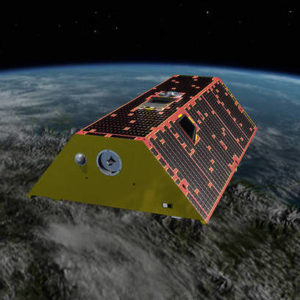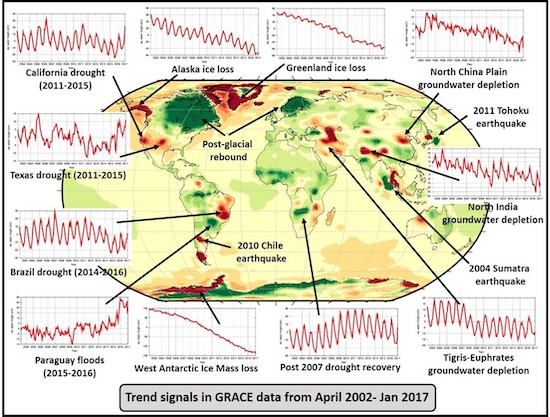 Researchers are using powerful supercomputers at TACC to process data from Gravity Recovery and Climate Experiment (GRACE).
Researchers are using powerful supercomputers at TACC to process data from Gravity Recovery and Climate Experiment (GRACE).
The University of Texas at Austin team that led a twin satellite system launched in 2002 to take detailed measurements of the Earth, called the Gravity Recovery and Climate Experiment (GRACE), reports in the most recent issue of the journal Nature Climate Change on the contributions that their nearly two decades of data have made to our understanding of global climate patterns.
Among the many contributions that GRACE has made:
- Consistent with a pattern of global warming, GRACE determined that annual ice loss of Greenland is 258 gigatons while the Antarctic is losing an additional 137 gigatons. The ice lost in the polar and mountainous regions from the mountainous regions is three times the loss in the pre-GRACE mission period.
- By determining that the mass added to the oceans contributes 2.5 mm/year of the 3.7 mm/year increase in global sea level, GRACE enabled a measure of the quantity of heat added to the ocean and the provided information related to the regional location of the heat absorption. GRACE observations confirming that the majority of the warming occurs in the upper 2,000 meters of the oceans.
- GRACE has observed that of the 37 largest land-based aquifers, 13 have undergone critical mass loss. This loss, due to both a climate-related effect and an anthropogenic (human-induced) effect, documents the reduced availability of clean, fresh water supplies for human consumption.
- The information gathered from GRACE provides vital data for the federal agency United States Drought Monitor and has shed light on the causes of drought and aquifer depletion in places worldwide, from India to California.
Intended to last just five years in orbit for a limited, experimental mission to measure small changes in the Earth’s gravitational fields, GRACE operated for more than 15 years and provided unprecedented insight into our global water resources, from more accurate measurements of polar ice loss to a better view of the ocean currents, and the rise in global sea levels. The mission was a collaboration between NASA and the German Aerospace Centre and was led by researchers in the Center for Space Research (CSR) in UT’s Cockrell School of Engineering.

Byron Tapley, established the Center for Space Research at UT Austin in 1981 and served as principal investigator of the GRACE mission
UT’s Texas Advanced Computing Center (TACC) has played a critical role in this international project over the last 15 years, according to Byron Tapley, the Clare Cockrell Williams Centennial Chair Emeritus in the Department of Aerospace Engineering and Engineering Mechanics who established the Center for Space Research at UT in 1981 and who served as principal investigator of the GRACE mission.
As the demand for the GRACE science deliverables have grown, TACC’s ability to support these demands have grown. It has been a seamless transition from the initial requirements supporting a demonstration of the concept to a much more demanding computational regime, supporting a much richer suite of scientific results,” Tapley said.
By measuring the changes in gravity associated with changes in the Earth’s mass distribution — water systems, ice sheets, atmosphere, land movements, and more — the satellites can measure small changes in the Earth system interactions.
By monitoring the physical components of the Earth’s dynamical system as a whole, GRACE provides a time variable and holistic overview of how our oceans, atmosphere and land surface topography interact,” Tapley said.
The data system for the mission is highly distributed and requires significant data storage and computation through an internationally distributed network. Although the final data products for the CSR solutions are generated at TACC, there is considerable effort in Germany by the Geophysics Center in Potsdam and the NASA Jet Propulsion Laboratory (JPL) in Pasadena, California. The final CSR analysis at TACC starts with a data downlink from the satellites to a raw data collection center in Germany. The data is then transmitted to JPL where the primary measurements are converted into the geophysical measurements consisting of GPS, accelerometer, attitude quaternions, and the high accuracy intersatellite ranging measurements collected by each satellite during a month-long observation span.
The challenging analysis of the collection of information data from this international community is enabled by the outstanding computing capability and operational philosophy at TACC. The consequence of this data collection and analysis effort has led to paradigm-shifting view of the Earth’s interactions,” Tapley said.
Despite being a risky venture operating on minimal funding, the GRACE mission surpassed all expectations and continues to provide a critical set of measurements.
“The concept of using the changing gravimetric patterns on Earth as a means to understanding major changes in the Earth system interactions had been proposed before,” Tapley said. “But we were the first to make it happen at a measurement level that supported the needs of the diverse Earth-science community.”
One of the remarkable benefits of working with TACC, according to Tapley, is the ability to pose questions whose solutions would have not been feasible prior to TACC and to find the capability to answer the questions.
As the demand for the GRACE science deliverables have grown, TACC’s ability to support these demands have grown. It has been a seamless transition from the initial requirements supporting a demonstration of the concept to a much more demanding computational regime, supporting a much richer suite of scientific results.”
“As an example, when we began the GRACE mission, we found it difficult to determine gravity models that were characterized by approximately 5,000 model parameters, whose solution was obtained at approximately yearly analysis intervals. The satellite-only GRACE models today are based on approximately 33,000 parameters that we now have the ability to determine these solutions at a daily interval. In the final re-analysis of the GRACE data, we’re looking to expand this parameterization to 4,000,000 parameters for the mean model. Future concerns involve assimilating the global GRACE mass changes into coupled atmospheric, ocean and land data models. As we consider these questions, our interaction with TACC has always been in the context of: “If the answer to a meaningful question requires extensive computations, let’s find a way to satisfy that requirement,'” Tapley said.
Now that the GRACE Follow-On mission, which the CSR will continue to play a role in, has launched successfully, the chance to continue the GRACE record for a second multi-decadal measurement of changes in mass across the Earth system is possible. Engineers and scientists anticipate that the longer data interval will allow them to see an even clearer picture of how the planet’s climate patterns behave over time.






TACC is one of the most important and productive supercomputer centers in the world. It would have been helpful to know which TACC assets were involved in this work.